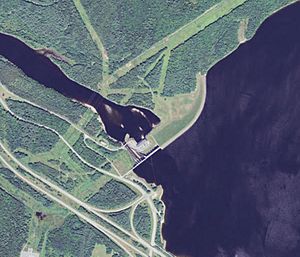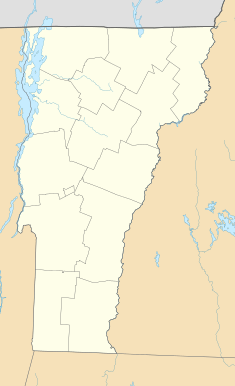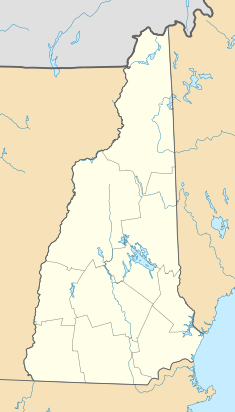Moore Dam facts for kids
Quick facts for kids Moore Dam |
|
|---|---|

Satellite view
|
|
|
Location of Moore Dam in Vermont#New Hampshire
|
|
| Country | United States |
| Location | New Hampshire and Vermont |
| Coordinates | 44°20′09″N 71°52′29″W / 44.33583°N 71.87472°W |
| Purpose | Hydroelectric |
| Construction began | 1954 |
| Opening date | 1956 |
| Owner(s) | TransCanada |
| Dam and spillways | |
| Type of dam | Embankment, gravity |
| Impounds | Connecticut River |
| Height (foundation) | 178 ft (54 m) |
| Length | 2,920 ft (890 m) |
| Spillway type | Gated overflow |
| Reservoir | |
| Total capacity | 223,722 acre⋅ft (275,957,000 m3) |
| Catchment area | 1,514 sq mi (3,920 km2) |
| Surface area | 3,490 acres (1,410 ha) |
| Normal elevation | 809 ft (247 m) |
| Power station | |
| Name | Moore Station |
| Type | Conventional |
| Hydraulic head | 150 ft (46 m) |
| Turbines | 4x 56,400 HP Francis |
| Installed capacity | 140.4 MW (rated) |
| Annual generation | 314,300,000 KWh (2009) |
Moore Dam is a big hydroelectric dam on the Connecticut River. It sits between New Hampshire and Vermont in the northeastern United States. The dam is near Littleton, New Hampshire. It creates a large lake called Moore Reservoir, which is about 3,490 acres big.
The power plant here, called Moore Station, is the biggest of its kind in New England. It makes a lot of electricity. The dam also helps control floods. People can go boating and fishing on the lake.
Its full name is the Samuel C. Moore Dam. It's named after a past president of the company that built it, the New England Power Company. Today, the dam, its lake, and the power station are owned and run by TransCanada Corporation.
Building the Dam
The Moore Dam is part of a bigger project called the "Fifteen Miles Falls" hydroelectric project. This project started in the early 1900s. Before the dams, the "Fifteen Miles Falls" was a fast-flowing part of the Connecticut River. The river dropped 350 feet over 15 miles, making it the longest stretch of whitewater in the northeastern US.
This steep and fast-flowing river was perfect for building water mills. Later, it became ideal for hydroelectric plants. In 1908, Carl A. Ross had the idea to build dams here. Two lower dams, Comerford Dam and McIndoe Dam, were finished in the early 1930s.
Work on the Moore Dam started in the mid-1930s. Workers cleared over 3,000 acres of land for the future lake. Two towns, Upper Waterford, Vermont, and Pattenville, New Hampshire, were taken down. However, work stopped because of the Great Depression.
Construction didn't start again until 1954. The dam was finally finished in 1956. It cost about $41 million to build. The dam officially opened and started making power on June 20, 1957.
How the Dam Works
Most dams on the Connecticut River have small lakes. These lakes only help control daily changes in water levels. But Moore Dam has a very large lake. This lake helps control river flows throughout the year. It also makes extra power when needed.
Along with Comerford Dam, Moore Dam helps reduce spring floods from melting snow. It also saves water for drier times of the year. In late fall or winter, the lake's water level is lowered. This makes space for the snowmelt that will come in spring. Workers measure the snow all winter. They adjust the lake levels based on these measurements. The lake's water level usually drops between 30 and 40 feet each season.
Moore Dam is one of only two dams in New Hampshire that has a person living on-site. This is because of its large size and important safety needs. The other dam with an on-site operator is the Murphy Dam.
Dam Facts
Moore Dam is made of earth and concrete. It is 178 feet tall and 2,920 feet long. The middle part is a 373-foot concrete section. On each side are long earthen sections, totaling 2,547 feet.
The spillway is on the concrete part. It has four gates to control water flow. There is one 15 by 20-foot sluice gate. There are also three 36 by 30-foot tainter gates. The spillway can handle a lot of water.
The power station is at the bottom of the dam. It has four large turbines. Each turbine powers a generator that makes 35,100 kilowatts (kW) of electricity. The plant can make 140,400 kW of power. In 2009, the Moore Station made 314,300 megawatt hours (MWh) of electricity.
The lake, Moore Reservoir, can hold a lot of water. Its full surface area is 3,490 acres. The area of land that drains water into the lake is 1,514 square miles. The Connecticut River's average flow here is 2,962 cubic feet per second. It flows fastest in April and slowest in August.
Environmental Impact
For many years before the dams were built, factories dumped waste into the Connecticut River. Each spring, floods would carry this waste to the ocean. When Moore Dam was built, this waste got trapped in the lake. It settled into the mud at the bottom. This made the water below 10 feet deep have very little oxygen.
For a long time, there was almost no aquatic life in the deeper parts of the lake. However, this has slowly gotten better. Many industries that polluted the river have closed. Also, new sewage treatment systems have been installed. But fish populations still need to be restocked each year.
The McIndoe Dam downstream blocks fish from swimming upstream. Because of this, Moore Dam was not built with ways for fish to pass. The dam is very tall. This makes it hard to add things like fish ladders. This is a problem for bringing back salmon to the Connecticut River. The best places for salmon to lay eggs are upstream of the dam.
Fun on the Lake
Moore Reservoir is one of the biggest "undeveloped" lakes in New England. This means there are not many private homes or businesses along its shores. The company that owns the reservoir, TransCanada, allows the public to visit.
There are four boat ramps on the New Hampshire side of the lake. There is also one ramp right below the dam. The dam has special paths for portage on both the Vermont and New Hampshire sides. This helps canoeists and kayakers carry their boats around the dam.
You can find many types of fish in the lake. These include salmon, trout, pike, pickerel, perch, bass, and sunfish. Because the lake is so big, it can have waves. Also, you might see a lot of floating tree trunks and other natural debris.




